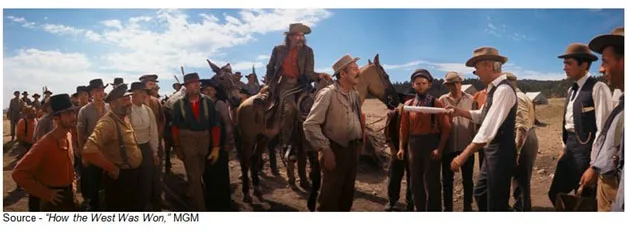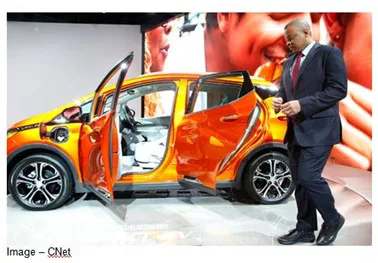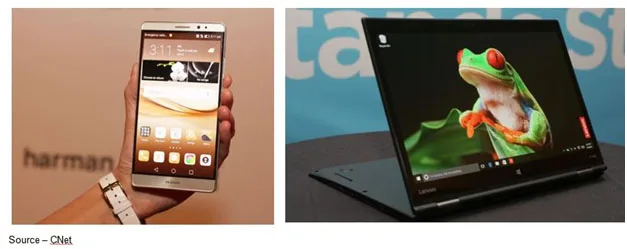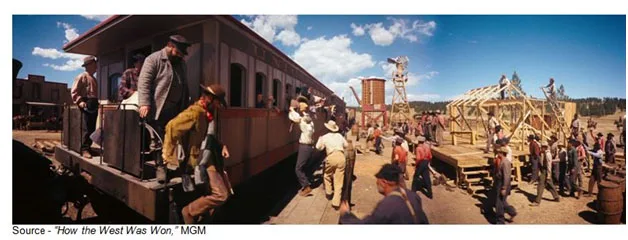Land Rush! – It’s Time to Civilize the IoT Wild West

Recently, I compared notes with Rob Enderle (Enderle Group) about the “good ol’ days” of smallish summer CES (Consumer Electronics Show) and the recent behemoth that featured everything from everyone, from everywhere.
Sure, there were some real products to be seen and a lot of neat things from folks who had maxed out their credit cards to get there hoping someone would write about them, would buy the product (or the company) but the show has expanded its horizons.
The big difference is now, the CTA-run (Consumer Technology Association) show is really a peek at tomorrow:
- How we’re going to plan/manage our cities/environment
- How folks are going to live, communicate, get around
- How we’re going to create, share, use data and plug all of the holes
To connect all of the IoT devices, even a loaded super freighter like the Ben Franklin wouldn’t be able to hold them all.

Thinking Long-Term
The industry has changed (a lot) to meet today’s/tomorrow’s infrastructure and usage needs.
Government and business folks came from everywhere to see how the industry could help with things like next-generation transportation, energy, entertainment, healthcare, water/waste and pollution issues.
Translation? It’s turning into a pretty big deal.
It’s not real noticeable because the noise is about sexy cars, neat wearables, cool drones/cameras, eye-poppin’ TVs, smartphones, computers (yes, computers!), cute thingies and; fun/business apps.
Smart city sensor hubs are being planned to measure everything from air quality to noise, humidity and temperature levels. They need microcontrollers, low-power connectivity and a multitude of microelectromechanical sensors (e.g., accelerometers, gyroscopes, digital compasses, inertial modules, pressure sensors, humidity sensors, sound and image sensors).
Upgrading the infrastructure plus changing people’s living/working conditions in countries and metropolitan areas are tailor made for IoT firms. Consulting firm Arup estimates that the global market for smart urban systems will amount to around $400 billion per year by 2020.
But as Roger Key, Endpoint Technologies, observed, there’s no grand architecture plan here, so everyone is making a land grab.
Everyone has the ideal solution, the right open standard.
That means we have a long way to go. A lot of this year’s neat ideas will quickly come and go, while others will morph into something totally better by 2020.
Tomorrow’s Car

Okay, CES is becoming a car show. The auto industry is determined to be your stylish technology … and more.
Electric cars that ignore the oil industry are just a start as tech and auto companies race (each other) to show off self-driving, semi-autonomous “crash-proof” vehicles.
From the wheels up, they’re adding sensors, apps and connectivity to be the center of your universe.
Ford, Toyota and almost every other car manufacturer have invested in massive tech centers around the globe and are hiring more electronic engineers and programmers than assembly workers to control their tomorrow rather than putting their future in the hands of Apple, MS, Nvidia, Google, Facebook, Amazon and the other component and software/app people.
Looking beyond your transportation, the auto folks are working on connecting your car (so much for shared cars) to your smart home network to control it as well. Tesla already announced car apps that will park, warm up and back the car out of the garage; and they think the car can do more
In Your Castle
But the CE industry players really want to be the ones helping you control your home, keep it safe, keep it efficient and keep you entertained.
The best way to do that is to start with a breathtaking entertainment center that is also the hub and data collection/sharing point for all of the sensors in the house – locks, lights, thermostat, robot vacuum, personal robot assistant, bathroom facilities and kitchen appliances.
Of course Apple (HomeKit), Samsung (SmartThings), Intel, LG (SmartThinQ), Panasonic (Ora), Google, Amazon, MS, Oracle, Cisco–all the big players– have their ideas as to what is best for all of your information management.
It works great as long as you stick with their stuff, their cloud.

While Samsung suggested the refrigerator should be your information control, LG, Panasonic and Vizio said the go-to center of your universe should be sets delivering HDR (high-definition resolution) UHD (ultra high-definition) 4K content.
The brighter, more vivid colors make viewing more fun; and when you add Dolby Atmos rich sound; entertainment totally beats the refrigerator.
The new TVs are the end point for all of the new content the M&E (media and entertainment) industry is developing for folks like you and me through the cable or OTT (over the top) – Netflix, Amazon, YouTube anywhere – and storing/sharing your information somewhere for you.
The Other Smart Hub

With all the IoT stuff everywhere at the show, it was easy for PCs and smartphones to find themselves sitting in the back watching the goings on–especially when IDC and Gartner reported PC sales were down in the fourth quarter and this year doesn’t look too promising.
Still, new systems were introduced and Apple beat the odds by gaining sales/marketshare. In addition, some cool technologies need pumped up computers to deliver their full potential.
They could be the logical home IoT manager since they’re the go-to choice for video gaming and serious PC horsepower is needed for serious VR (virtual reality) viewing and entertainment.
And with a home-shared 24TB storage device like OWC’s ThunderBay 4 sitting next to your Mac or PC, it’s a little safer than the other guy’s cloud!
Almost every car, home, other IoT device has an app available for your smartphone; and face it, you don’t go anywhere without it.
So your smartphone is a logical choice for your personal IoT smart hub.
The big unveil for the new devices and apps will be at the February Mobile World Congress in Barcelona.
You can bet they’ll be a lot easier to carry than your refrigerator.
All about You
Suddenly everyone just knows you’re dying to get fit!
That’s why fitness bands, smart watches (pitching themselves against the segment leader – Apple Watch) and a gazillion apps to monitor/measure everything, send all that cool data to your smartphone and somewhere else were everywhere at CES.
But suddenly that is becoming so yesterday.
Stylish fitness-focused smart clothes that give you accurate fitness metrics and detailed analysis of your workout have entered the scene.

Samsung, Google, OMSignal, Hexo Skin, Under Armuor, the entire rag industry is interested in putting sensors on your body – shorts, tops, socks, shoes, everywhere.
Still, the idea of sensors in my underwear? Nawww!
Next year, you can be sure that Shapiro and his CTA team will have a special MAGIC area. In case you didn’t know, MAGIC is the fashion showplace of apparel, footwear, accessories.
What’s Holding it Back?
Everything at CES was so effortlessly connected with other things in the booths, it was tough to pick the winners.
But!
We live in a fairly free enterprise world so everyone has their flavor of car, home, personal IoT open standard
They just don’t talk well or sometimes at all with each other. If you pick the wrong route you’re SOL.

For all of the CES IoT eye candy to work, it has to exchange information – lots of continuous streams of information – with everything else, somewhere.
Maybe CTA could take on the role of negotiating a single worldwide standard?
That’ll keep ‘em busy between CESs!
Most of the information that will fly around is personal…yours and your family members i.e., who you are, where you are, what you do, what you consider/think.
Sure, you already post most of that stuff on social sites around the web, but there’s something to be said for security and privacy.
Of course, CNet, CNN, USA Today, the New York Times, ReCode and every news outlet constantly warn us that 60+ percent of those fantastic secure/safe apps we use have holes in them and the usual response is, “We’re working on that.”
Which leads to the big issue of people readily hacking all that information to use it for whatever.
It’s going to happen!
As the How the West Was Won narrator said, “The West that was won by its pioneers, settlers, adventurers “ who had “all the heritage of a people free to dream, free to act, free to mold their own destiny.”
 For companies to reach their destiny, the consumer technology industry needs standards that CTA and other standards groups can “negotiate” for consumers. Companies can then focus on products that help make the digital transition easier and faster. There will still be plenty of room for them to add features/capabilities that will get Enderle excited at the show.
For companies to reach their destiny, the consumer technology industry needs standards that CTA and other standards groups can “negotiate” for consumers. Companies can then focus on products that help make the digital transition easier and faster. There will still be plenty of room for them to add features/capabilities that will get Enderle excited at the show.
# # #